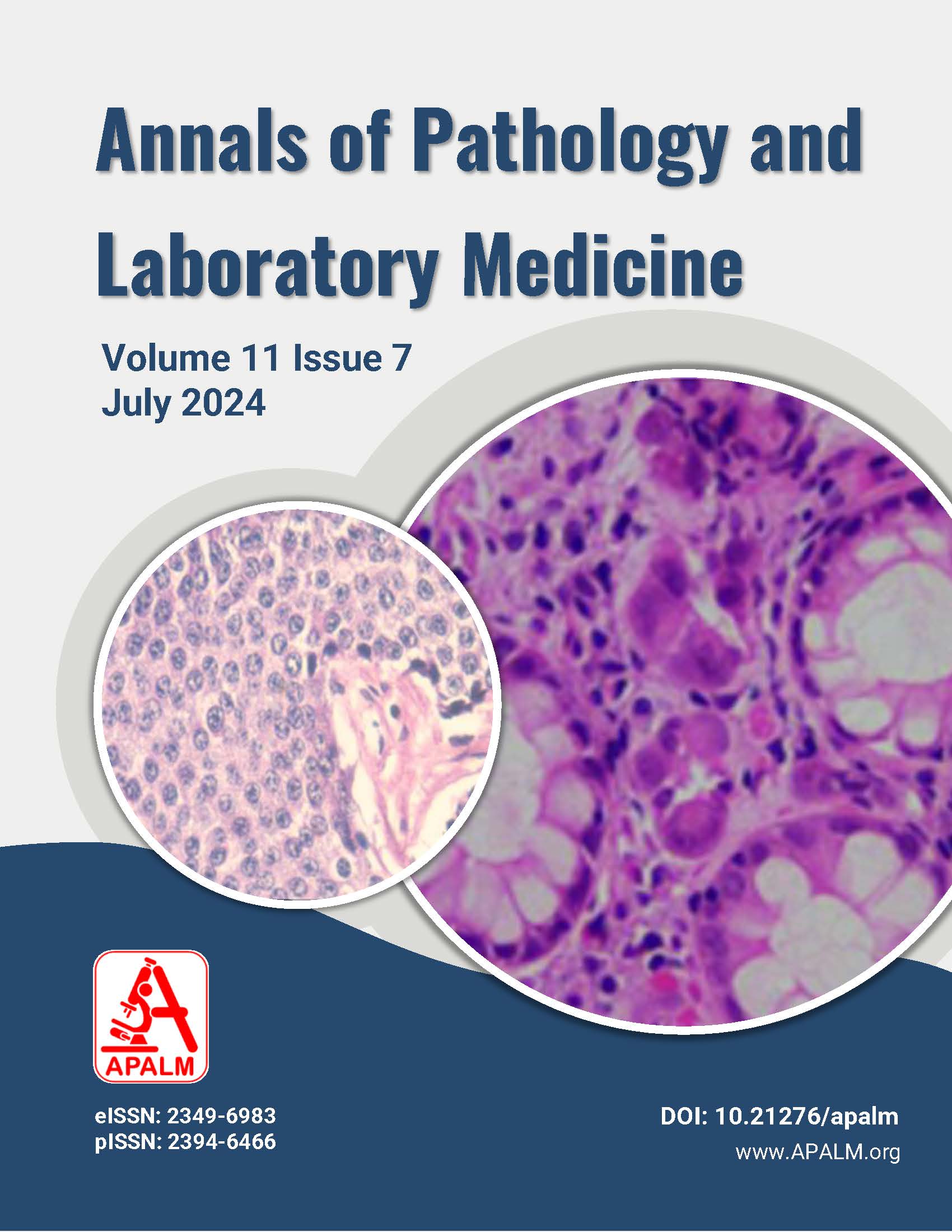Unveiling the Spectrum: Pathological Perspectives on Neuroendocrine Neoplasms
DOI:
https://doi.org/10.21276/apalm.3351Keywords:
Neuroendocrine neoplasm, biopsy, grading, pathology spectrumAbstract
Background
Neuroendocrine neoplasms (NENs) account for only 0.5% of all malignancies. The incidence is approximately 2 per 100,000 with a female preponderance under the age of 50 years. The main primary sites are the gastrointestinal tract (62-67%) and lungs (22-27%). In the last decade, the incidence has been rising, which might be due to more awareness, improved diagnostic tools, or a change in definition. Neuroendocrine neoplasms are sporadic, but association with the MEN1 syndrome and clustering within families is known. The 5-year survival is mainly associated with the stage of disease: 93% in local disease, 74% in regional disease, and 19% in metastatic disease.
Method
Biopsies received in the Department of Pathology, B.J. Medical College, Ahmedabad over the past 2 years were included. Biopsies were fixed and processed by routine paraffin method, stained by H&E, and also immunohistochemistry was performed.
Results
A total of 50 cases were received, with about 56% males and 44% females, with a median age of 50 years. In our study, most of the tumors were found in the gastro-entero-pancreatic system, followed by the breast and broncho-pulmonary group. NENs were graded based on mitotic count. In total, 12 had G1 grade, 15 had G2 grade, 22 had G3 grade, and 1 was placed in the NEC category. Lymph node or distant site metastasis was not found in any of the cases.
Conclusion
According to our study, the age of presentation of NENs is in the 5th to 6th decade, and the majority occur in the GEP group. Grading of NEN should be carried out according to the latest WHO criteria and is crucial for prognosis and management of patients.
References
Hallet J, Law CH, Cukier M, Saskin R, Liu N, Singh S. Exploring the rising incidence of neuroendocrine tumors: a population-based analysis of epidemiology, metastatic presentation, and outcomes. Cancer. 2015 Feb 15;121(4):589-97.
Klimstra DS, Beltran H, Lilenbaum R, Bergsland E. The spectrum of neuroendocrine tumors: histologic classification, unique features and areas of overlap.
Gheorghișan-Gălățeanu AA, Ilieșiu A, Lambrescu IM, Țăpoi DA. The complex histopathological and immunohistochemical spectrum of neuroendocrine tumors—an overview of the latest classifications. Int J Mol Sci. 2023;24(2):1418.
Zandee WT, van der Zwan JM, de Herder WW, van Velthuysen ML. Importance of complete pathology reporting for neuroendocrine carcinoma: WHO guidelines are a good start but not enough.
Samanta STN, Mehta SP, Patel TS, Jetly DH. Clinicopathological study of 100 cases of neuroendocrine neoplasms of the gastroenteropancreatic system: a tertiary cancer center experience. Indian J Med Paediatr Oncol. 2020;41(3):340-4.
Silveira F, Basile ML, Kuga FS, Próspero JD, Paes RA, Bernardi FDC. Neuroendocrine tumors: an epidemiological study of 250 cases at a tertiary hospital.
Bräutigam K, Rodriguez-Calero A, Kim-Fuchs C, Kollár A, Trepp R, Marinoni I, Perren A. Update on histological reporting changes in neuroendocrine neoplasms. Curr Oncol Rep. 2021 Apr 14;23(6):65.
Rosai J, Ackerman LV, Rosai J. Rosai and Ackerman’s Surgical Pathology. 10th ed. New York: Mosby; 2011.
Choe J, Kim KW, Kim HJ, Kim DW, Kim KP, Hong SM, et al. What is new in the 2017 World Health Organization classification and 8th American Joint Committee on Cancer staging system for pancreatic neuroendocrine neoplasms? Korean J Radiol. 2019 Jan;20(1):5-17.
Abdulfattah MK, Al-naqqash MA. The clinico-epidemiologic characteristics of Iraqi patients with neuroendocrine tumors and their response to long acting octreotide. J Fac Med Baghdad. 2016 Jan 3;58(4):312-5.
Yao JC, Hassan M, Phan A, Dagohoy C, Leary C, Mares JE, et al. One hundred years after “carcinoidâ€: epidemiology of and prognostic factors for neuroendocrine tumors in 35,825 cases in the United States. J Clin Oncol. 2008 Jun 20;26(18):3063-72.
Hauso O, Gustafsson BI, Kidd M, Waldum HL, Drozdov I, Chan AK, Modlin IM. Neuroendocrine tumor epidemiology: contrasting Norway and North America. Cancer. 2008 Nov 15;113(10):2655-64.
Hafeez U, Joshi A, Bhatt M, Kelly J, Sabesan S, Vangaveti V. Clinical profile and treatment outcomes of advanced neuroendocrine tumours in rural and regional patients: a retrospective study from a regional cancer in North Queensland, Australia. Intern Med J. 2017 Mar;47(3):284-90.
Kapoor R, Bhattacharyya T, Gupta R, Mittal BR, Kalra N. A systematic review of management of neuroendocrine tumors: an experience from a tertiary care centre from India. Clin Cancer Investig J. 2014 Sep 1;3(5):363-72.
Sirohi B, Barreto SG, Shrikhande SV, Bhandare M, Bal M, Chacko RT, et al. Indian Council of Medical Research consensus document for the management of gastroenteropancreatic neuroendocrine neoplasms. Indian J Med Paediatr Oncol. 2020;41(2):166-72.
Kulkarni RS, Anand AS, Parikh SK, Panchal HP, Patel AA, Mehta DP, Patel P. Clinical and epidemiological profile of neuroendocrine tumors: an experience from a regional cancer center from Western India. South Asian J Cancer. 2019 Jul-Sep;8(3):198-202.
Muscogiuri G, Barrea L, Cantone MC, Guarnotta V, Mazzilli R, Verde L, et al. Neuroendocrine tumors: a comprehensive review on nutritional approaches. Cancers (Basel). 2022 Sep 10;14(18):4402
Downloads
Published
Issue
Section
License
Copyright (c) 2024 Bhumi Rameshchandra Bhuva, Hemina Himanshu Desai, Twinkle Bhashyantkumar Thakkar, Aesha Amrish Parikh, Hansa Goswami

This work is licensed under a Creative Commons Attribution 4.0 International License.
Authors who publish with this journal agree to the following terms:
- Authors retain copyright and grant the journal right of first publication with the work simultaneously licensed under a Creative Commons Attribution License that allows others to share the work with an acknowledgement of the work's authorship and initial publication in this journal.
- Authors are able to enter into separate, additional contractual arrangements for the non-exclusive distribution of the journal's published version of the work (e.g., post it to an institutional repository or publish it in a book), with an acknowledgement of its initial publication in this journal.
- Authors are permitted and encouraged to post their work online (e.g., in institutional repositories or on their website) prior to and during the submission process, as it can lead to productive exchanges, as well as earlier and greater citation of published work (See The Effect of Open Access at http://opcit.eprints.org/oacitation-biblio.html).










